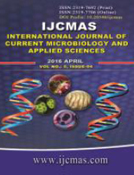


 National Academy of Agricultural Sciences (NAAS)
National Academy of Agricultural Sciences (NAAS)

|
PRINT ISSN : 2319-7692
Online ISSN : 2319-7706 Issues : 12 per year Publisher : Excellent Publishers Email : editorijcmas@gmail.com / submit@ijcmas.com Editor-in-chief: Dr.M.Prakash Index Copernicus ICV 2018: 95.39 NAAS RATING 2020: 5.38 |
Llamas are ruminant mammals belonging to the camelids family, which also suffer from gastrointestinal parasites. Thus, in vitro studies under laboratory conditions were conducted to evaluate the predatory activity of fungal isolates in in vitro biological control of gastrointestinal nematode parasites in llamas, coming from a zoo in southeastern Brazil. The species Duddingtonia flagrans (AC001 and CG768); Arthrobotrys conoides (I40); Arthrobotrys robusta (I31); Monacrosporium sinense (SF53) and Monacrosporuim thaumasium (NF34) were used in the experiment, grown in 2% agar-water culture (AW2%) in 9.0 cm in diameter petri dishes. After seven days of interaction it was observed that all fungal isolates were efficient in the capture and destruction of L3, however, not differing in their predatory activity within each other (p> 0.01), but differing from the control group. At the end of the experiment the following reduction percentages were obtained 87.56% (AC001); 90.45% (CG768); 93.07% (I40); 94.58% (I31); 90.28% (SF53); 92.30% (NF34), in relation to the control group. It was concluded that all fungal isolates were effective in the in vitro biological control of L3 nematodes in llamas. However, larger studies, particularly in the field are required toobtain a more effective control of the free life forms of these parasites in Lamasraised in a zooin southeastern Brazil.
 |
 |
 |
 |
 |